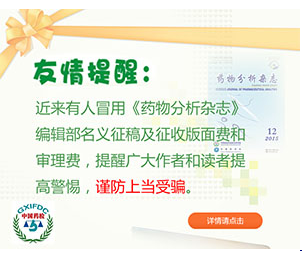目的:建立药用明胶空心胶囊样品中22种合成色素的超高效液相色谱/三重四极杆质谱定量分析方法。方法:样品经60 ℃水、乙醇-水(7:3)及乙腈浸泡超声提取,提取液采用聚酰胺粉吸附,固相萃取柱净化,分别以无水乙醇-水(3:7)、无水乙醇-2%氨水-水(7:2:1)、乙腈解吸附,洗至聚酰胺粉无色;收集解吸液,旋蒸浓缩,加50%乙腈定容,经0.22μm滤膜过滤,进样分析。结果:10种限用色素线性浓度范围为5~500 mg·L-1,12种禁用色素的线性浓度范围为0.002~12.5 mg·L-1;22种合成色素均得到有效提取,加标提取回收率为72.1%~100.3%,检出限为0.5~284μg·L-1;146批次样品中,GB2760-2014规定允许作为食品添加剂使用的11种合成色素中,共检出8种,分别为柠檬黄、亮蓝、胭脂红、赤藓红、苋菜红、诱惑红、日落黄、喹啉黄,其中柠檬黄与亮蓝使用频率较高;禁用的合成色素中,15批次样品检出坚牢绿。结论:该方法对药用明胶空心胶囊中合成色素的定量分析有良好的适用性。采用建立方法,对多家企业产品进行测定,发现合成色素存在滥用现象,鉴于合成色素的危害性,其在制药工业中的使用品种、使用限量和安全性评价以及标签标示管理等方面应引起重视。
Objective: To establish a quantitative analysis method for 22 synthetic pigments by liquid chromatography-tandem mass spectrometry. Method: The sample was soaked and extracted by 60 ℃ water、ethanol-water(7:3) and acetonitrile. After extraction, the solution was absorbed by polyamide powder, then purified by solid phase chromatography, desorbed by absolute alcohol-water(3:7)、absolute alcohol-2% ammonia solution-water(7:2:1) and acetonitrile until the polyamide powder became colorless. The collected solution was concentrated by rotary evaporation, diluted by 50% acetonitrile and filtrated by 0. 22 μm filter membrane, then quantified by UPLC-MS/MS. Results: The results showed that for the 10 limited synthetic pigments, the linearity range was 5-500 mg·L-1;For the 12 forbidden synthetic pigments, the linearity range was 0. 002-12. 5 mg·L-1;22 synthetic pigments were all extracted effectively. The spiked recoveries ranged from 72. 1%-100. 3%, and the detection limits ranged from 0. 5-284 μg·L-1. In 146 batches of samples, 8 of 11 kinds of synthetic pigment permitted to be used as food additives by GB 2760-2014 were detected. They are citric yellow, bright blue, carmine, erythrosine, amaranth, temptation red, sunset yellow and quinoline yellow, respectively. Among these pigments, lemon yellow and light blue are used much more frequently. Fast green, a forbidden pigment was found in 15 batches. Conclusion: The method is suitable for quantitative determination for 22 synthetic pigments in medical gelatin capsule shells. Samples from different manufacturers were tested by established methods and abuse of synthetic pigments was found. In view of the dangers of synthetic pigment in pharmaceutical industry, we should pay more attention to the varieties、the limit、safety evaluation and label management of these products.




